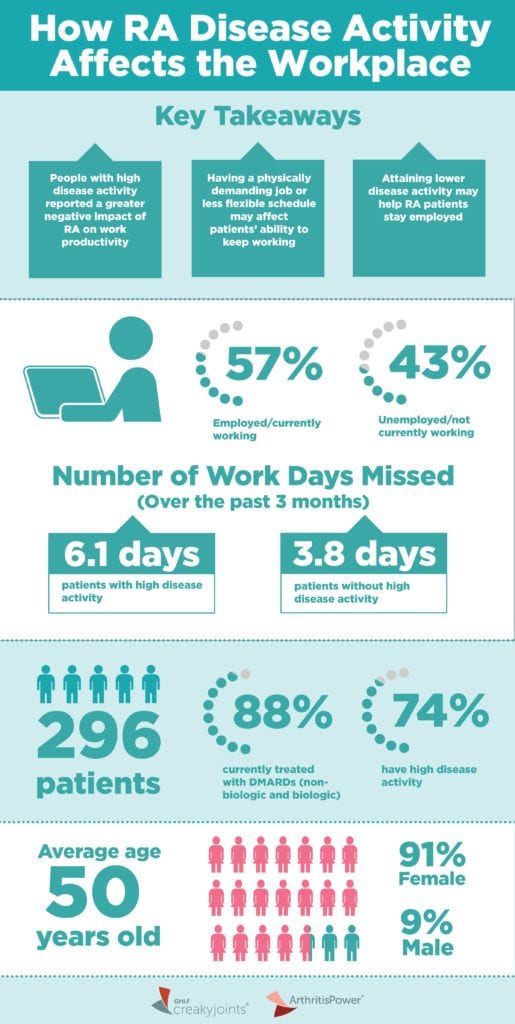When you think of a disease like rheumatoid arthritis — with joint pain, fatigue, and unpredictable flares, among other symptoms — it’s hardly surprising that people living with RA experience challenges in the workplace.
Whether you’re a teacher who has to stand for long periods or sit cross-legged on the floor with young students, have a sales job where you spend much of your day driving from client to client, or are chained to an office desk with large chunks of time typing emails, it’s hard to think of a job where RA symptoms don’t take a negative toll.
Indeed, many people with inflammatory arthritis like rheumatoid, psoriatic, and ankylosing spondylitis in the CreakyJoints community have had to stop working altogether or change jobs to positions that are less physically taxing.
But no research to date has associated the degree of disease activity with such factors as employment status, work productivity, and workplace environment from the perspective of people living with RA.
In a recent study presented at the 2018 American College of Rheumatology/Association of Rheumatology Health Professionals (ACR/ARHP) Annual Meeting in Chicago, researchers, including those from the Global Healthy Living Foundation, surveyed 296 rheumatoid arthritis patients about their workplace through our ArthritisPower research registry.


Of those, 88 percent were currently being treated with DMARDs (non-biologic and biologic) and 74 percent reported having high disease activity based on their responses to the RAPID3 health assessment. Respondents also answered questions about their pain interference, fatigue, sleep disturbance, physical function, and social participation.
Here’s what we learned.
How Disease Activity Affects Your Ability to Work
1. Days Missed
Disease activity plays a big role in how present people with RA can be at work. People with high disease activity (HDA) missed an average of six days over the span of three months compared with less than four days missed among people with low disease activity. The most frequent reason for missing work days was RA symptoms.
2. Productivity
RA disease activity also influenced how productive people reported being at work. On a scale from 0 to 10 (where 0 meant no effect on work and 10 meant that RA completely prevented people from working), participants with high disease activity reported a greater negative impact of RA on their work productivity (5.3 on the scale) than patients without high disease activity (3.3 on the scale).
3. Reasons for Missing Work
Interestingly, the degree of disease activity also affected why people had to miss work. People without high disease activity missed more days to attend medical appointments than HDA participants, whereas people with high disease activity missed more days due to side effects from RA treatment.
The study shows that despite the widespread use of DMARDs to treat RA symptoms, many people remain significantly impacted by symptoms of their disease, including their ability to work.
How Your Workplace Environment Affects Your Ability to Work
Participants who were not currently employed (nearly 43 percent of the total people surveyed) reported more physically demanding work environments and less flexibility in scheduling and working from home in their most recent job than participants who were still currently working.
These factors might explain why people had to stop working.
“It seems flexibility is key to help people with RA keep working,” says study coauthor W. Benjamin Nowell, PhD, director of Patient-Centered Research at the Global Healthy Living Foundation. “If people with RA can talk to their employers about reducing heavy physical activity, allowing them to spend less time standing or in a physically uncomfortable environment, and providing a flexible schedule, such as working from home part of the week, they may be able to keep working longer than RA patients who can’t make those adjustments to their jobs.”
But there might be a limit to flexibility too, the study data showed. Surprisingly, participants who could request changes in work start and quit times on a daily basis were 2.9 times more likely to not be currently employed than those unable to make this request.
“Flexibility may need to be balanced with reliability,” says study coauthor Kelly Gavigan, MPH, data scientist at the Global Healthy Living Foundation. If someone is changing on a daily or near-daily basis when they arrive at work or leave for the day, that might be challenging for managers to keep track of.
It’s likely better for both people with RA and their employers if rules about flexibility can be established up front rather than made on the fly.
This study was done with support from Bristol-Myers Squibb.
Get Involved in Arthritis Research
If you are diagnosed with RA or another musculoskeletal health condition, we encourage you to participate in future studies by joining CreakyJoints’ patient research registry, ArthritisPower. ArthritisPower is the first ever patient-led, patient-centered research registry for joint, bone and inflammatory skin conditions.
Keep Reading
- This Advice Can Make Your Daily Work Life with Inflammatory Arthritis a Little More Bearable
- 7 Tips that Can Help You Cope with Arthritis Fatigue
- Got Painsomnia? These 9 Patient-Tested Tips May Help You Sleep Well Again





